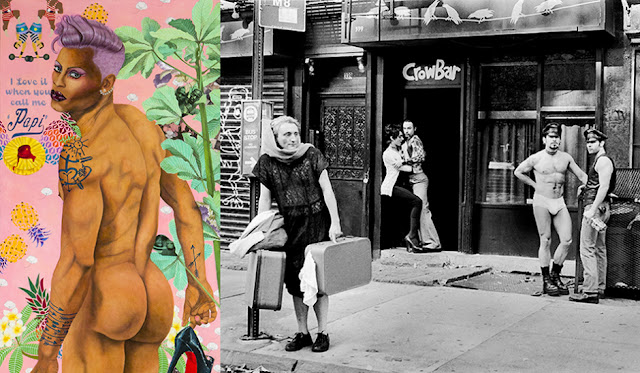Though in
Western tradition, gender is understood as male and female, many world
cultures, especially Native American culture, do not have such a precise
division. Instead there is provision for, movement back and forth between
genders. “Two Spirits” refers not just to the two artists exhibiting, but also
evokes a body simultaneously housing both a masculine and a feminine spirit.
This exhibit is also inspired by the interplay between spirituality, activism,
and queerness, as seen in the longing felt by many people of indigenous descent
to connect to this earlier, lost heritage.
Borinquen
artists Geraldo Castro and Luis Carle’s works evidence how the radical
influences pop culture, including ongoing pushback and questioning of gender
roles. Castro painting of visually masculine nude men adorned in feminine
trappings juxtaposes roles and notions of traditional beauty. Photographer Luis
Carle’s nostalgic imagery recorded gay life and activism in New York City in
the early eighties, and revisiting this work now reminds us of the necessity of
more activism, as we see what has changed and what has not.
These Two
Spirits, and other men like them, take on an important role in the art
community; they are healers, visionaries and valued for their balanced
perception of existence and a way of being.
"The WAVE", March for Civil Rights Bill. Washington DC. 1993"
Luis Carle
was born in Puerto Rico and moved to New York City in 1984. Carle first studied
photography at Parsons School of Design and worked as artist and photographer’s
assistant to various well-known photographers including Rebecca Blake, Michel
Haddi, Mark Liddell, Arturo Melero and others. In the 1990s, Mr. Carle started
working for various magazines and newspapers including: Latina Magazine, CRN
Magazine, Footwear News, El Diario La Prensa, San Juan Star and El Nuevo Día.
Mr. Carle joined advertising campaigns like Cutty Sark, AT&T, OBRI Cosmetics,
and participated in many documentary films. In 1992 he founded and directed
O.P. Art, Inc. (The Organization of Puerto Rican Artists, Inc.), a
not-for-profit artist’s collective, that has been recognized as an important
source of Latin art by the New York Regional Center of the Smithsonian
Institute (1999), The Museum of Modern Art (2006), the NYC Library, and
accepted by NYFA’s Fiscal Sponsorship program. Luis was the visual arts curator
for the NuyoRican Poets Café in the East Village, New York.
Carle’s
photographs have captured the essence of a life well lived and have been
included in The New York Times, Daily News and other art magazines. His artwork
has appeared in galleries and museums in New York, including the Museo del
Barrio’s first S-Files Biennial (1999), The African American Museum, Centro
Gallery at the Center for Puerto Rican Studies (Hunter College), MOCADA: Museum
of Contemporary African Diaspora Arts, and The Museum of Modern Art; and
abroad, in The Caribbean Museum (St. Croix, Virgin Islands), Museo of
Contemporary Arts (Puerto Rico), Museo de las Americas (Puerto Rico), The Hague
Arts Center (The Hague, Netherlands) and the Sarkowsky Gallery (St Petersburg,
Russia). He has photographs in the permanent collections of The National Portrait
Gallery of the Smithsonian Institution (Washington DC) and the Leslie-Lohman
Museum of Gay and Lesbian Art (New York).
He writes:
“For decades, the dominant cultural image of masculinity has included
heterosexuality, physical strength, financial success, having many children,
manly mannerisms and not crying or showing emotion. Society has coded
intellect, passivity, softness, emotional intelligence, compassion,
care-taking, and sensitivity as feminine, and therefore weak. Being masculine
or feminine doesn’t make us less of a man or a woman. Masculinity is not
inherently better than femininity; the two are different, and both hold
special, powerful aspects. In the Latino culture there’s a belief that men need
to be hyper-masculine, domineering, controlling, and without the slightest hint
of femininity.”
Gerardo Castro, “Flor and FLorecita”, oil on paper, 24” x 6 feet.
Castro has
exhibited in the following selected art shows, galleries and museums.
Biblioteca Nacional, Havana Cuba; Wilmer Jennings Gallery NY, SOMArts Cultural
Center, San Francisco, Human Rights Institute, Kean University, NJ: Aphrodisiac
‘Agua’, Santo Domingo, DR; In Search of Queer Gods, Root Division, San
Francisco, Museum of the History of Ponce, PR, Social Justice: St. Mary’s
College Museum of Art, Morago, CA; Niger to Afrofuturism, Westfield State
University, Westfield, MA; The World After January 20, 2017, Vassar College,
Poughkeepsie, NY.
In Castro’s
current series, rather than concealing features that would be deemed unattractive
beneath the male gaze, he glorifies them, posing questions around whether
masculinity is nature or nurture; passed down through generation to generation,
or individually assumed and often hidden behind. Castro has created images
rooted in ethnicity and gender as well as culturally dominant fantasies about
masculinity and sexuality that have escaped the trappings of popularized
constructions of Latino identity; work that enables a connection to history and
his roots, a courageous confrontation of meaning and mysticism. Castro seeks to
uncover the hidden culture of machismo, a conflict between two identities; gay
and Latino: a tension between identity and reality that can be incredibly
detrimental to the Latino community; tragedy of machismo is that a man is never
quite man enough.
Two Spirits
Curated by
Jo-El Lopez
Eleta J.
Caldwell and Rodney M. Gilbert Memorial Gallery, Gallery Aferro
April 7 – May 26, 2018
Opening
Reception April 7th 7-10pm
Gallery
Aferro 73 Market Street, Newark NJ.




Comentarios
Publicar un comentario